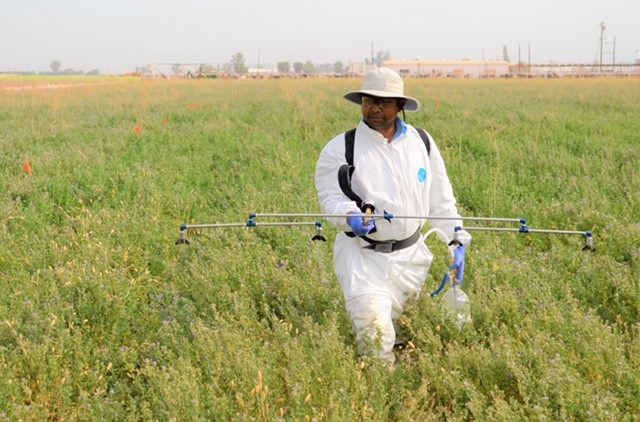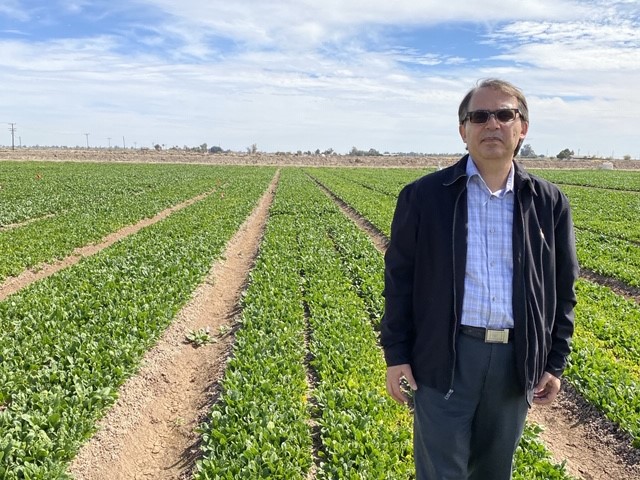
On a stretch of highway between El Centro and Holtville, nestled among green farm fields, is the home of the University of California Cooperative Extension, where research critical to ensuring Imperial Valley crops and livestock remain healthy is conducted daily.
For Dr. Oli Bachie, director of the Cooperative Extension, it is a non-stop challenge to apply research to such key issues as pest control, food safety and water management to address the unique needs of Imperial Valley agriculture.
There is a great deal at stake in the research and outreach effort he leads with his team of advisers as the Valley is home to nearly a half-million acres of irrigated farmland in production — a $4 billion economic driver for Imperial County and a critical part of the food chain for the nation and the world.
“Having the relationships with the stakeholders and local governments is a satisfaction as you extend services as a county director,” said Bachie, who not only leads the Cooperative Extension in the Valley, but also the San Diego County program.
While he has led the local program since 2016, the Cooperative Extension has actually been a part of the Imperial Valley since 1916, which means the program has been serving the region for more than 100 years, making it one of the longest-running cooperative extensions in the UC system.
The Cooperative Extension is an arm of the University of California Division of Agriculture and Natural Resources (UCANR). With a focus on agricultural research, the work of UCANR includes studies done on UC campuses and separately in field research done in all 58 California counties. The local program is housed in the same campus as the UC Desert Research and Extension Center on Holton Road, just outside Holtville. The Cooperative Extension and Desert Research and Extension Center are separate but complementary programs under UCANR.

The focus research areas for UCANR include agriculture and pest management, food and safety, environmental and natural resources, innovation to promote economic development, and research related to yard and garden care. Additionally, UCANR oversees the 4-H youth and community nutrition (CalFresh) programs that introduce agriculture to young people and the community.
“Our work is about applied research and extending that research to our clientele,” Bachie said. “The research findings are explored in workshops, meetings, field days and local newsletter publications and other media outlets.”
In the Imperial Valley, the research focus has largely targeted pest management, crop adaptability, sustainable food production, food safety, crop water use efficiencies and livestock care – all related to the Valley’s unique conditions and issues.
“The low desert is very unique,” Bachie said. “The hot and dry environment provides ideal growing conditions but enhances some unique pests that have to be addressed.”
Another unique condition, he said, comes from the Colorado River, which supplies water with high salinity levels to Imperial Valley farms.
“We have to manage salinity and still have a system for consistent crop production,” said Bachie, who reports monthly to the Imperial County Farm Bureau to keep farmers up to date on the work of the Cooperative Extension and the latest threats to agriculture.
Cooperative Extension work has led to innovative crop developments. One example, Bachie said, is the development of Rhodes grass, which is gaining prominence in the hay industry as a highly drought- and salt-tolerant perennial. Rhodes grass is an alternative crop gaining acceptance following three years of testing by the Cooperative Extension.
“This is one of the really beautiful examples of the studies we do. This crop was tested for the first time in the low desert,” said Bachie. It is now being grown locally, in Central California and Arizona.
One more critical matter the Cooperative Extension is exploring relates to the banning in 2021 of a commonly used insecticide, chlorpyrifos, which was critical to field crops in the desert, such as alfalfa, sugar beets and some other crops.
“We immediately put together research to look at what the growers need,” Bachie said. “We want to look at other insecticides that would be safe and effective for operations and serve as alternatives.”

That research has led to key advancements, including a seed-coating formula to protect seedlings, especially from such pests as the flea beetles, which prey on sugar beet crops in their initial stages of growth.
Steps still need to be taken to protect crops in their late-season phases, he said. However, if young crops are protected and kept healthier, that will keep them more resilient in their later phases, which can help them withstand late-season pests.
Water efficiency is another research area where the Cooperative Extension’s work has served the needs of the Valley, where farming operations have been implementing conservation in a way that generates water conservation but also maintains and enhances agriculture in the Valley.
“The focus has been on finding irrigation strategies that help crops to yield better, but also resist plant pathogens,” Bachie said.
The research also led to irrigation systems that remove any randomness to the irrigation process, ensuring crops are not overwatered or underwatered, but receive the exact amount of irrigation they require — which both conserves water and supports the crops.
For local growers, the Cooperative Extension has been an important support in addressing issues, like pests and disease, when they occur.
“I can tell you that the Cooperative Extension is an asset here in the Imperial Valley,” said local grower Paula Pangle. “The team there has been essential in helping us identify pests and diseases, and deal with them so that we can continue to grow strong and healthy crops to feed the nation and the world.”
Scott Howington, the immediate past president of the Imperial Valley Vegetable Growers Association, said Cooperative Extension advisers have been here to provide necessary information to vegetable growers of the valley.
“They are very important to the Valley,” Howington said. “They bring a lot of information to the Vegetable Growers Association. They are there when you need them for information, and if they don’t know the answer, they will get it for us from other resources.”
Carlos Ortiz, Imperial County Agricultural Commissioner, praised innovations in local agriculture that have come from the Cooperative Extension research and the discoveries that have saved local crops.
“The University of California Cooperative Extension is very important to our local agricultural industry, as well as to our urban landscape,” Ortiz said. “The research performed by the farm advisers involves many of the agricultural practices of growing a crop. Some of the benefits from the research include the establishment of new crops, managing pests and diseases, developing new or improved fertilization and irrigation practices, to name a few. The presence of our local UC Cooperative Extension provides the opportunity of conducting research specific to our weather, soil, water, and other unique conditions.”
He added, “I have personally witnessed the efficiency and practicality of local research. Examples that I can share are the response to the presence of sugarcane aphid that could have potentially affected our local Sudan grass industry, finding alternative pesticides to the loss of a pesticide, such as chlorpyrifos, providing information to industry about the potential cross pollination of different cultivars of hemp, and the list goes on.”
As Bachie and the Cooperative Extension look to the new year, he highlighted that the UCANR is moving forward with critical staff additions statewide and in the low desert that will allow for the addition of two new specialized advisers — one a food safety and organic production adviser, and the other a plant pathology adviser.
With food safety an ongoing priority, Bachie said, the food safety and organic production specialist will focus on improving food safety with vegetable crops while also finding ways to promote organic production in the Valley, which is nearing 50,000 acres.
The plant pathologist will be a critical addition to the local office in that the adviser will be able to diagnose diseases in crops locally, speeding up the time it takes to understand any new disease and address it. Currently, without that position, when issues in crops are spotted, cultures must be collected and sent out of the Valley for diagnosis.
“This will allow us to provide an immediate response,” Bachie said of the new position.

In continuing to look at the new year, Bachie said, he and his colleagues are focusing on outreach in the community to build awareness about two grant programs that could bring in new funding to farmers — the State Water Efficiency and Enhancement Program, and the Healthy Soil Program.
The Cooperative Extension, he said, is prepared to offer training and support to those wishing to seek grant funding through either program. The period to apply for a grant extends through February 2022, and he is hoping more farmers and ranchers consider applying.
“I want to encourage the community that this is a way for low desert farmers and ranchers to secure new funding,” he said, adding that two years ago his office assisted in bringing $1.1 million into the Valley in grant funds, and he’d like to see that happen again.
This story by Darren Simon first appeared in the Valley Agribusiness & Desert Digest magazine in January.